Caring for outdoor bonsai is all about finding that sweet spot with humidity and watering. In summer, I water once or twice a day to keep my little tree happy and hydrated, while in winter, I ease up—don’t let it dry out completely though! And hey, use rainwater if you can; it’s like a spa day for your bonsai. Ready to create a mini rainforest and check your soil? Let’s get those bonsai vibes thriving!
Quick Takeaways
- Water outdoor bonsai daily in summer and adjust frequency during winter, spring, and autumn based on climate conditions and moisture needs.
- Use gentle watering techniques, soaking the soil until water drains out and performs a moisture check before re-watering.
- Ensure high-quality soil for bonsai retains moisture while providing excellent drainage and aeration to prevent root rot.
- Prefer using rainwater with optimal pH levels (6.0 to 6.5) and avoid softened or high-mineral tap waters to protect your bonsai.
- Maintain humidity by utilizing humidity trays, regular misting, and strategic placement in shadier areas to create a moisture-rich environment.
Understanding Watering Frequency for Outdoor Bonsai

When it comes to keeping your outdoor bonsai thriving, understanding watering frequency is like mastering the rhythm of a bonsai dance—without the right moves, your tree won’t flourish.
In summer, I find myself watering my bonsai once or even twice a day, as the thirsty little guys suck up moisture like it’s a fine nectar. Climate effects play a crucial role in how often you need to hydrate them, as hot and dry conditions will demand more frequent attention.
Come winter, it’s a nice slow waltz; I scale back as growth slows, but don’t let them dry out completely—trust me, that’s a disaster waiting to happen!
Spring calls for more frequent watering as they spring into life, and autumn? Well, it’s a balance depending on your climate.
Proper Watering Techniques for Bonsai Care
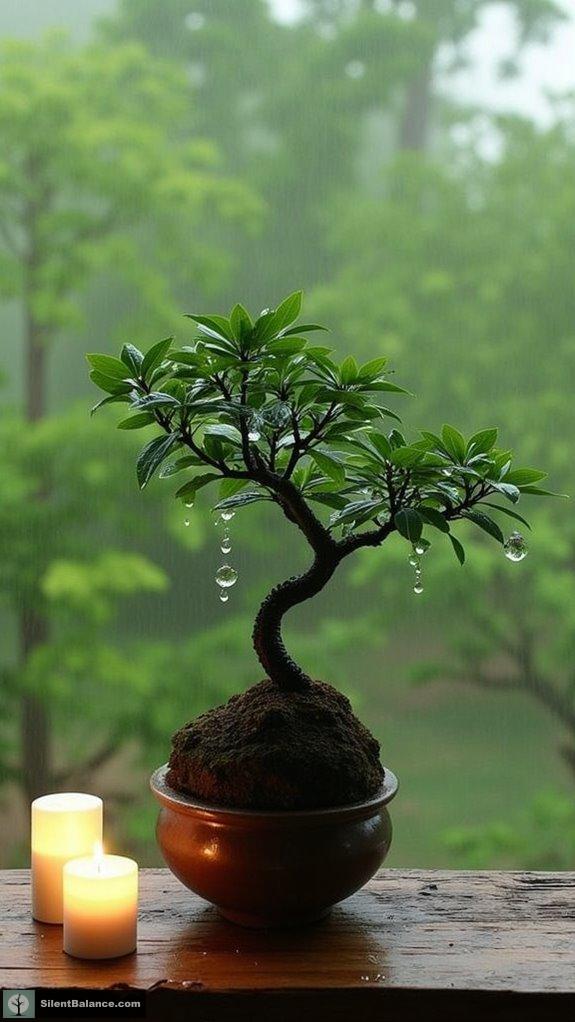
Proper watering techniques are the heartbeat of successful bonsai care, and mastering these methods can transform your little green wonder into a thriving miniature masterpiece.
Picture this: I gently water my bonsai, letting the droplets gracefully cascade over its leaves, ensuring every inch of that canopy gets a drink. It’s like a shower for my leafy friend! It’s important to adjust my watering schedule with the changing seasons, particularly in harsh summer months when evaporation rates increase.
I keep pouring until I see water streaming out the drainage holes, soaking for an extra minute just to pamper those roots.
But hey, don’t rush it! I check the soil; if it’s still muddy, I’ll hold off. I use room temperature rainwater to keep things cozy. Remember, proper watering can enhance bonsai vitality, so finding the right balance is key.
Keep in mind, bonsai don’t do well in droughts, but be careful not to drown them, either. Easy peasy, right?
Importance of Soil and Drainage in Bonsai Health
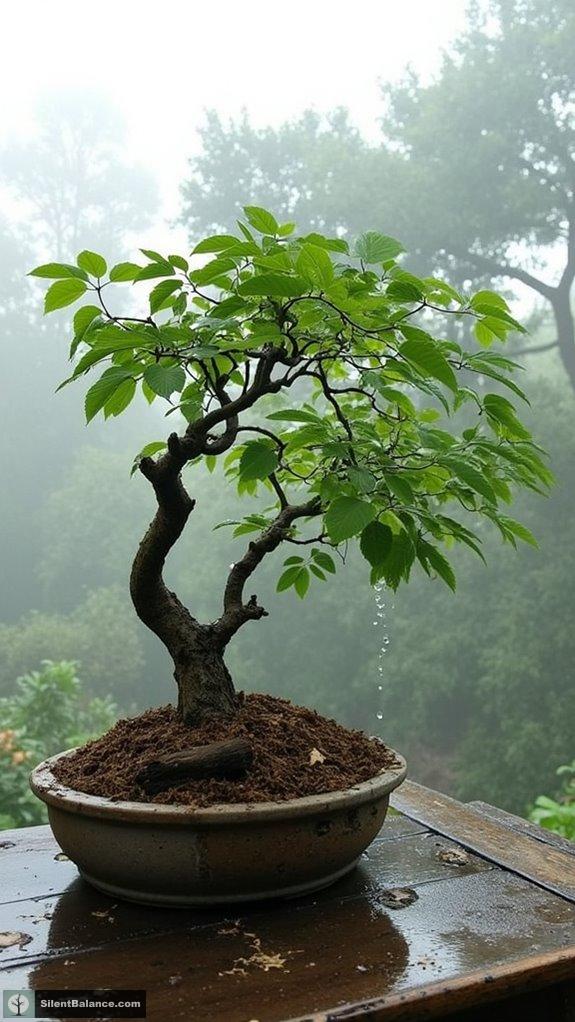
Soil and drainage are the unsung heroes of bonsai health, playing a vital role in the overall thriving of your little tree.
Think about it, without the right soil mix, your bonsai could be on a slippery slope to disaster. Here’s what you need:
- Water retention keeps the roots hydrated between waterings—no more thirsty trees!
- Excellent drainage guarantees that water flows freely, preventing root rot—nobody wants a soggy bottom!
- Adequate aeration allows roots to breathe—think of it as your bonsai’s personal spa day.
- Optimal pH (6.5 to 7.5) is essential for nutrient uptake—keeping it balanced brings your bonsai to life.
Additionally, choosing the correct soil composition can enhance the cultural significance of your bonsai, connecting you to the profound history of this art form.
With the right blend, watch your bonsai flourish like a star on opening night!
Ensuring Quality Water Sources for Your Bonsai
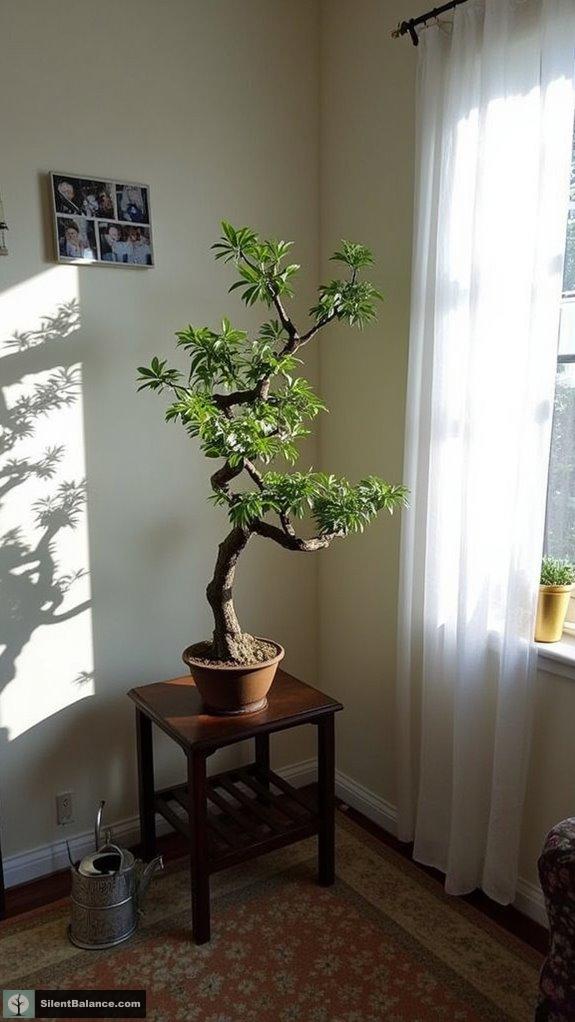
Great soil and drainage are just the tip of the iceberg when it comes to keeping your bonsai thriving.
Now, let’s plunge into the water—the lifeblood of your mini green wonder.
Did you know the ideal pH for your bonsai is between 6.0 and 6.5? Tap water often throws a party at 7.5 or higher, usually resulting in nutrient party crashers. Yikes!
I can’t stress enough how fabulous rainwater is; it’s like liquid gold for your bonsai—with low minerals and just the right acidity.
Avoid water softened with those pesky salts that can harm your roots.
And hey, don’t forget to measure regularly, or you may unknowingly turn your bonsai oasis into a salty mess.
Cheers to happy watering!
Maintaining Humidity Levels for Optimal Bonsai Growth
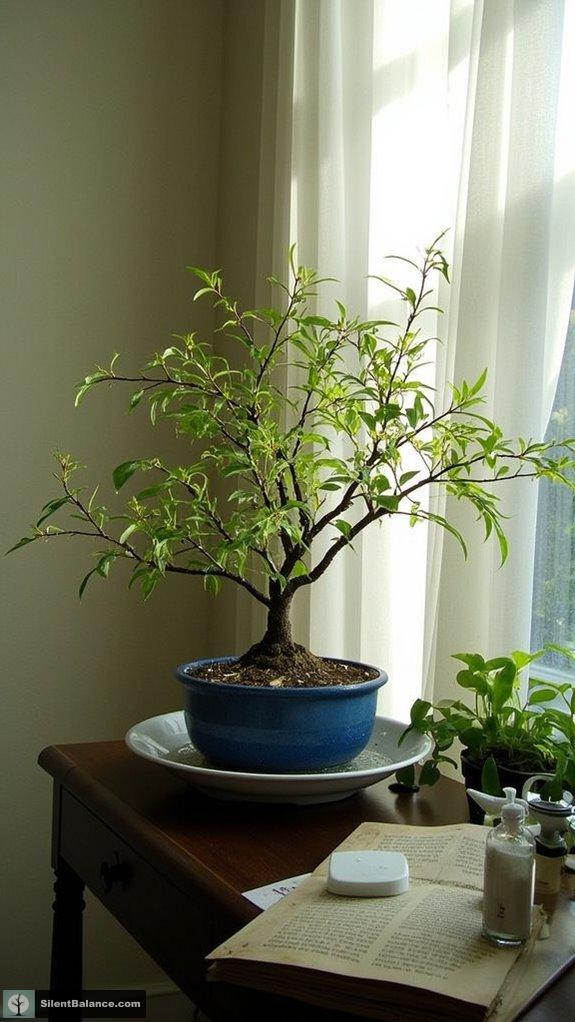
Have you ever wondered why humidity is the unsung hero of bonsai care?
Maintaining the right humidity levels is essential for keeping our delicate bonsai happy and thriving. To make it easier, here are a few tips I’ve found helpful:
- Use a humidity tray filled with water under your bonsai pots; it creates a mini rainforest!
- Regularly mist the leaves; it’s like a spa day for your bonsai.
- Create a moisture-rich environment by wetting nearby surfaces.
- Position your bonsai in shadier gardens; they’ll love the extra humidity!
Keep in mind that specific species have unique needs, so always adjust based on what makes your bonsai smile.
Happy bonsai gardening!
Bonsai Tree Symbolism
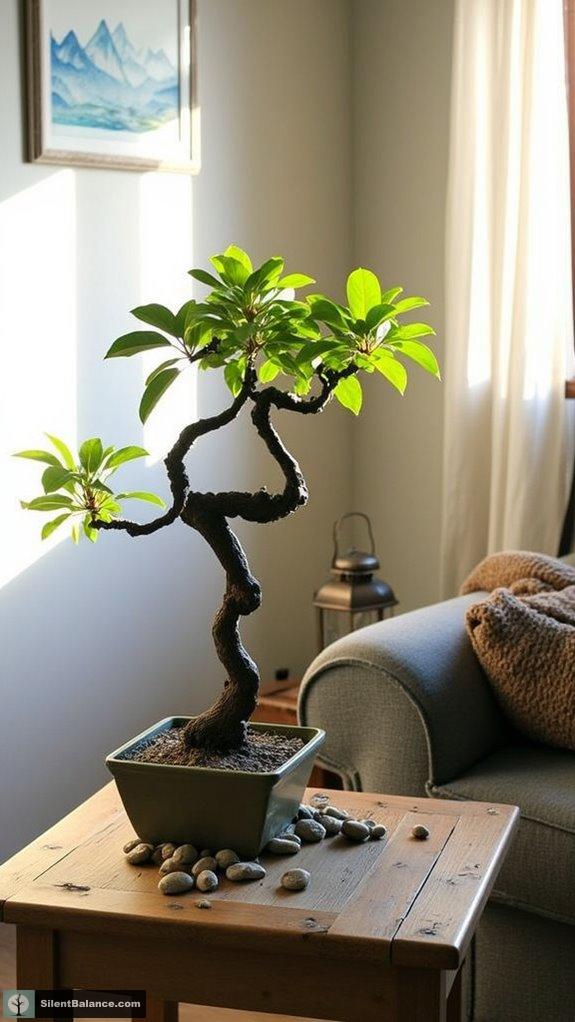
Bonsai tree symbolism radiates an enchanting blend of artistry, culture, and spirituality that’s hard to ignore.
These miniature marvels have roots deep in history—originally called “penjing” in China, signifying beauty and status.
Can you conjure the tranquility they brought to royal courtyards?
When Zen Buddhists in Japan adopted them, they morphed into symbols of meditation and simplicity.
Owning a bonsai isn’t just about aesthetics; it embodies balance, patience, and a deep connection to nature.
Isn’t that a lovely thought?
Each unique species carries its own vibe—peace, harmony, or spiritual growth.
Tree Symbolism
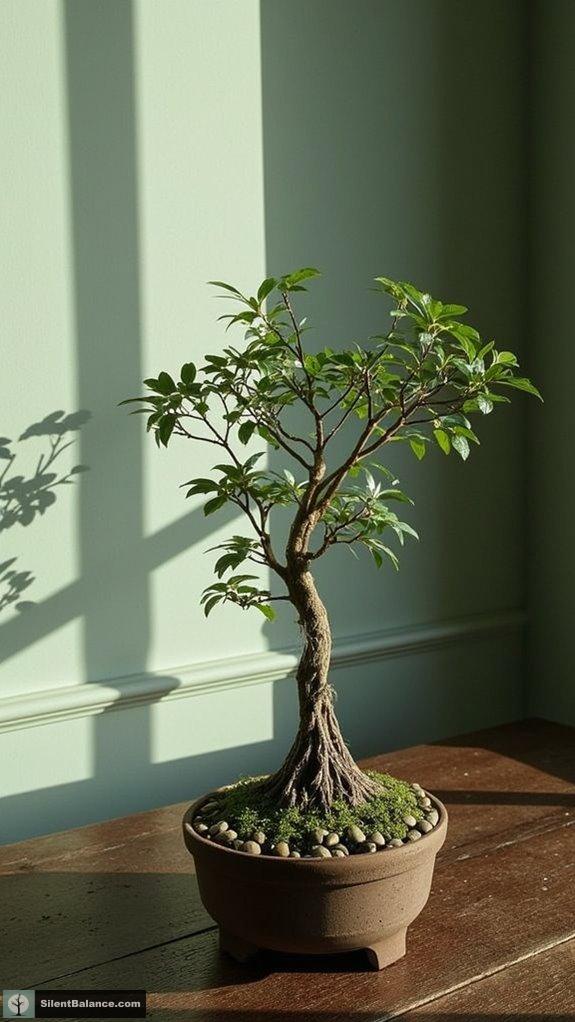
Trees aren’t just towering titans of the natural world; they hold profound meanings and stories that span cultures and centuries. Their symbolism is rich and inviting, begging us to explore deeper into their essence.
Here are a few highlights:
- The Acacia in Ancient Egypt symbolizes rebirth, tied to Osiris.
- The Celtic Tree of Life (Crann Bethadh) connects us to our ancestors, emphasizing growth and renewal.
- In Norse legend, Yggdrasil links nine domains, illustrating our interconnected existence.
- The Bodhi Tree, sacred in Buddhism, embodies enlightenment and spiritual awakening.
Questions and Answers
Can I Use Distilled Water for My Bonsai?
Absolutely, I typically use distilled water for my bonsai. Just keep in mind, it lacks minerals, so I always supplement with nutrients to keep my trees healthy and vibrant. It really makes a difference in their growth!
What Should I Do if My Bonsai Gets Too Much Rain?
If my bonsai gets too much rain, I treat it like a delicate flower in a storm. I quickly drain excess water, check for root damage, and guarantee it gets good airflow to recover.
How Does Wind Affect Outdoor Bonsai Watering Needs?
I’ve noticed wind dramatically increases my bonsai’s watering needs. During gusty days, I find myself checking moisture levels more frequently, understanding that those relentless breezes can quickly dry out both the soil and foliage.
Is It Necessary to Water Bonsai in Winter?
You might think it’s unnecessary, but I still water my bonsai in winter. Just a bit, mind you. It keeps their roots from drying out completely, even when they’re dormant and seemingly lifeless.
Can I Move My Bonsai Indoors During Extreme Weather?
I understand your concern about moving your bonsai indoors during extreme weather. Just keep in mind, it’s essential to wait until temperatures drop too low before bringing them in to avoid shocking them.
References
- https://brusselsbonsai.com/recommended-care/
- https://bonsai4me.com/a-guide-to-watering-bonsai/
- https://libanswers.nybg.org/faq/222665
- https://www.youtube.com/watch?v=yMKjZKAoqH8
- https://www.jacksonandperkins.com/how-to-care-for-bonsai-tree/a/how-to-care-for-bonsai-tree/
- https://www.bonsaigalinou.com/en/blog/complete-guide-to-watering-bonsai-techniques-frequency-and-pra-tips-n72
- https://www.bonsaiempire.com/basics/bonsai-care/watering
- https://www.bonsaiempire.com/tree-species/outdoor-bonsai
- https://www.bonsaioutlet.com/watering-basics-for-bonsai-trees/
- https://www.youtube.com/watch?v=AIt8piVt3P8
- https://www.gardeningknowhow.com/houseplants/bonsai/bonsai-soil-requirements.htm
- https://bonsai4me.com/an-introduction-to-bonsai-soils/
- https://www.bonsaiempire.com/basics/bonsai-care/bonsai-soil
- https://www.bonsaiempire.com/blog/bonsai-soil-requirements
- https://bonsaitonight.com/2021/03/07/what-kind-of-soil-should-i-use-for-my-bonsai/
- https://www.bonsai-en.com.au/post/water-ph-and-why-it-matters-to-bonsai
- https://bonsaitonight.com/2019/08/16/how-to-lower-the-ph-of-your-water-to-keep-bonsai-healthy/
- https://www.bonsaify.com/blogs/news-and-more/is-my-water-good-for-my-bonsai
- https://bonsaiandbrewstudio.com/blogs/news/bonsai-temp-humidity
- https://bonsaiwest.com/resources/bonsai-care/
- Unique Bonsai Pots for Zen Home Decor - September 6, 2025
- 7 Essential Tips for Selecting Outdoor Bonsai Tree Containers - September 6, 2025
- Perfect Pots for Thriving Tropical Bonsai Tree Containers - September 5, 2025

